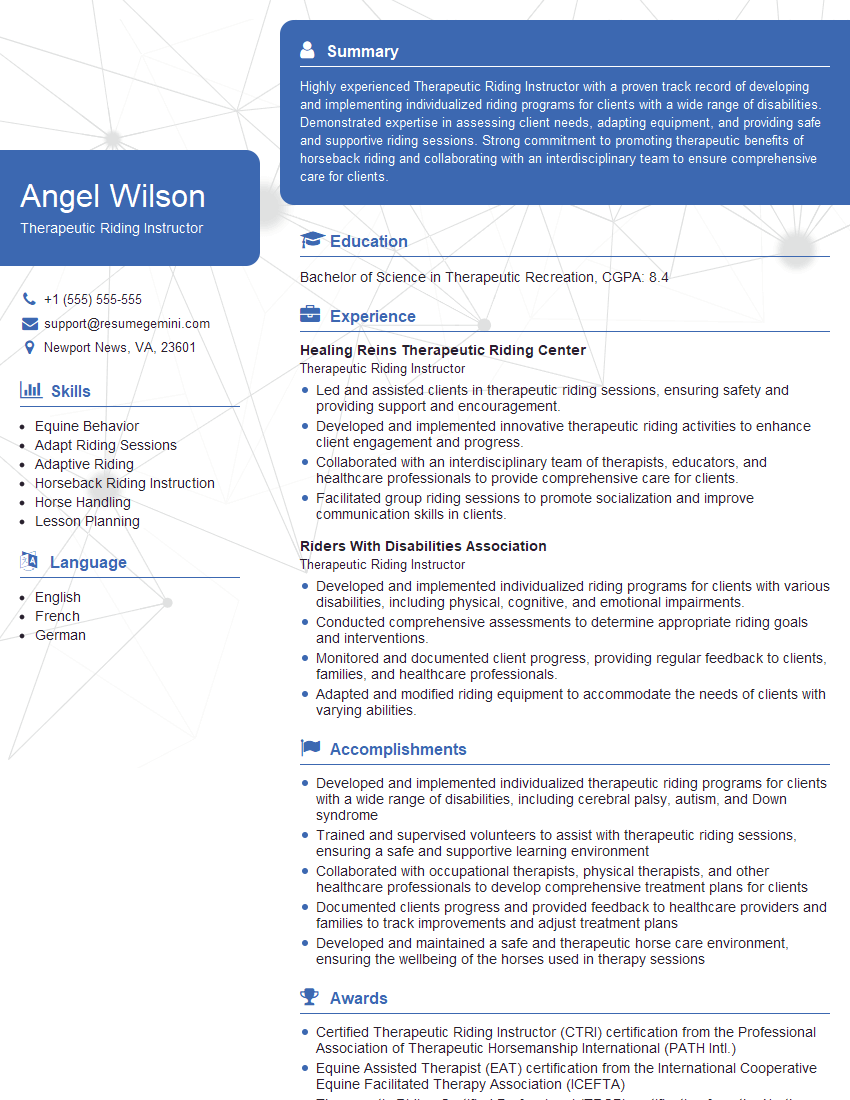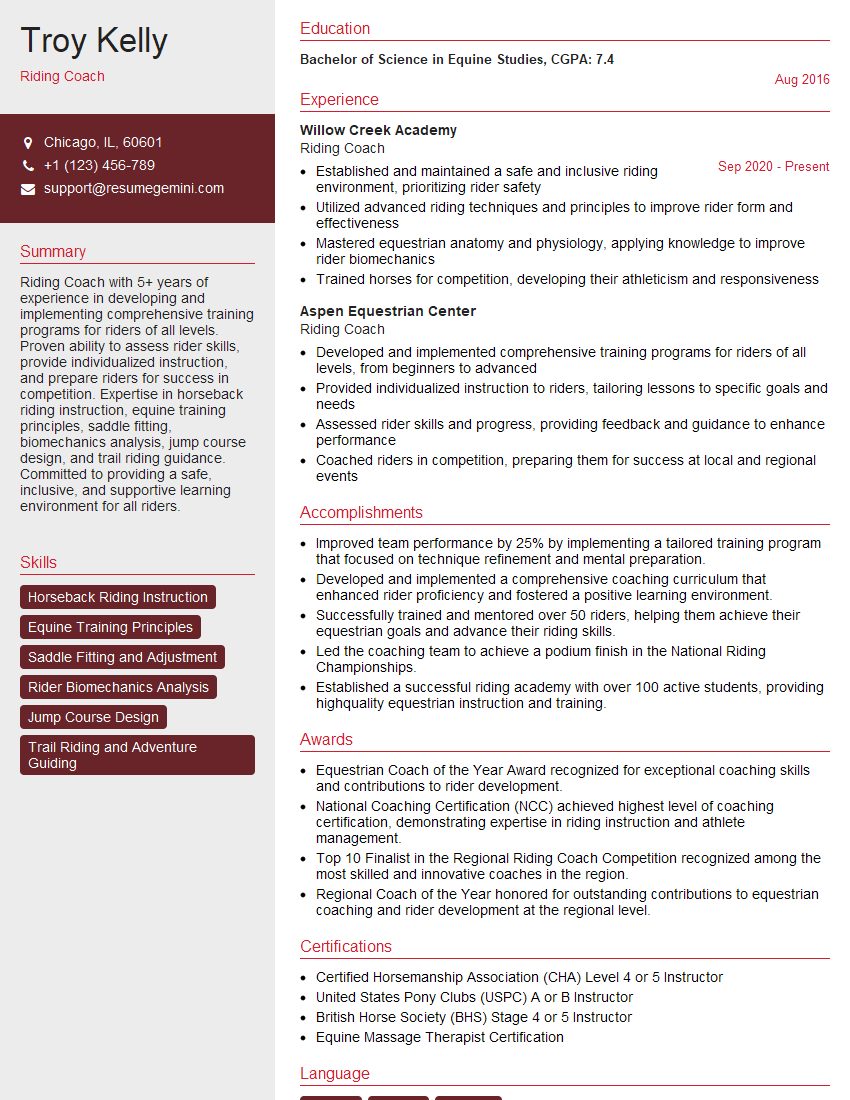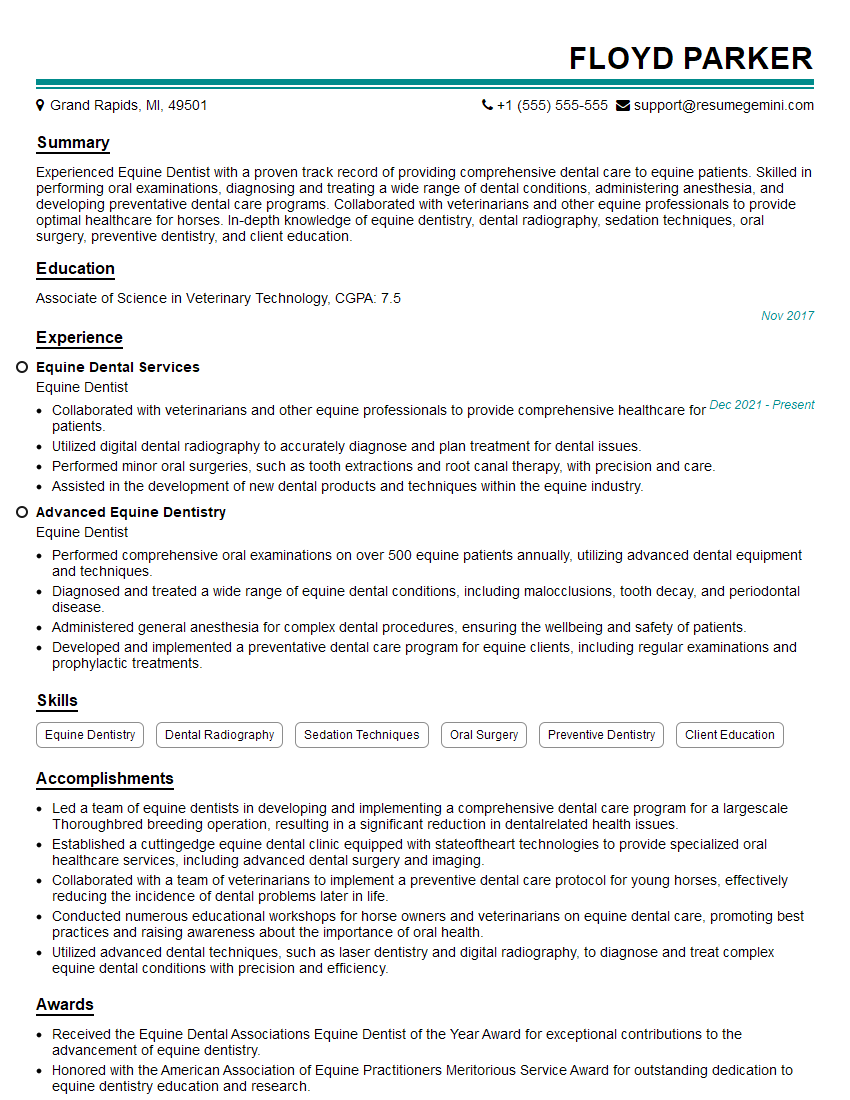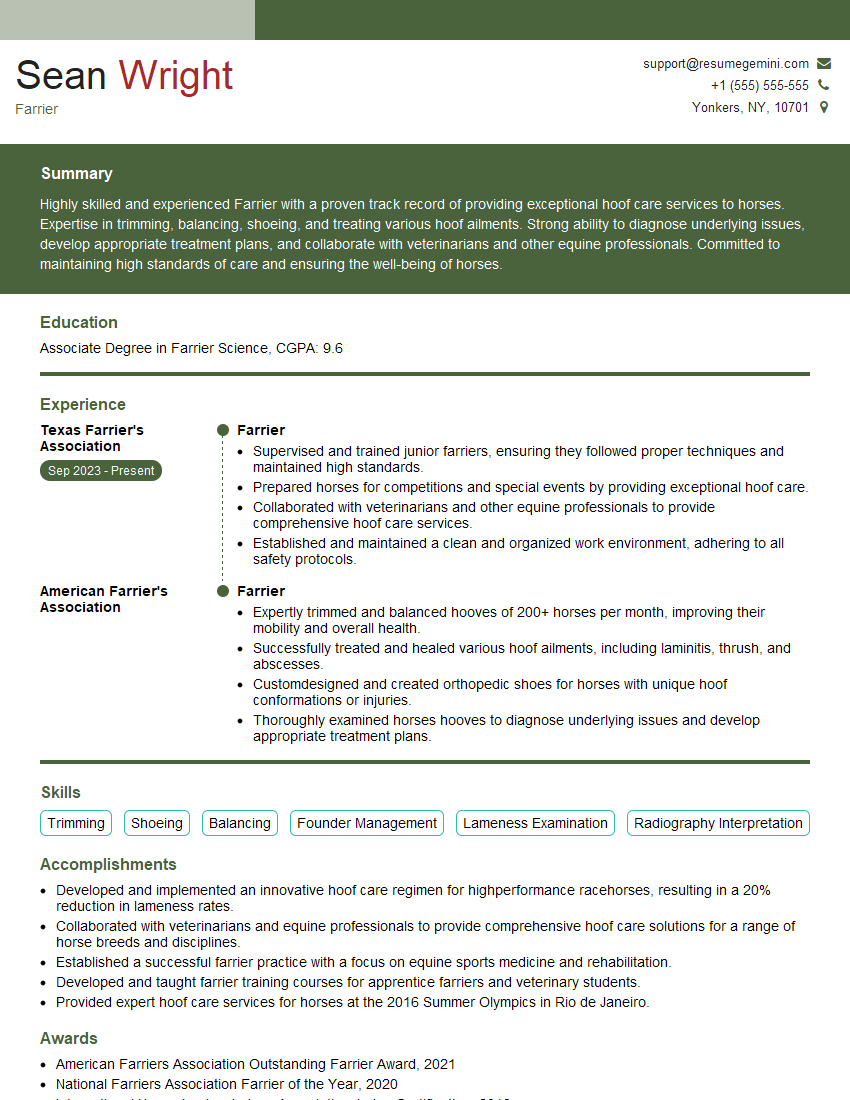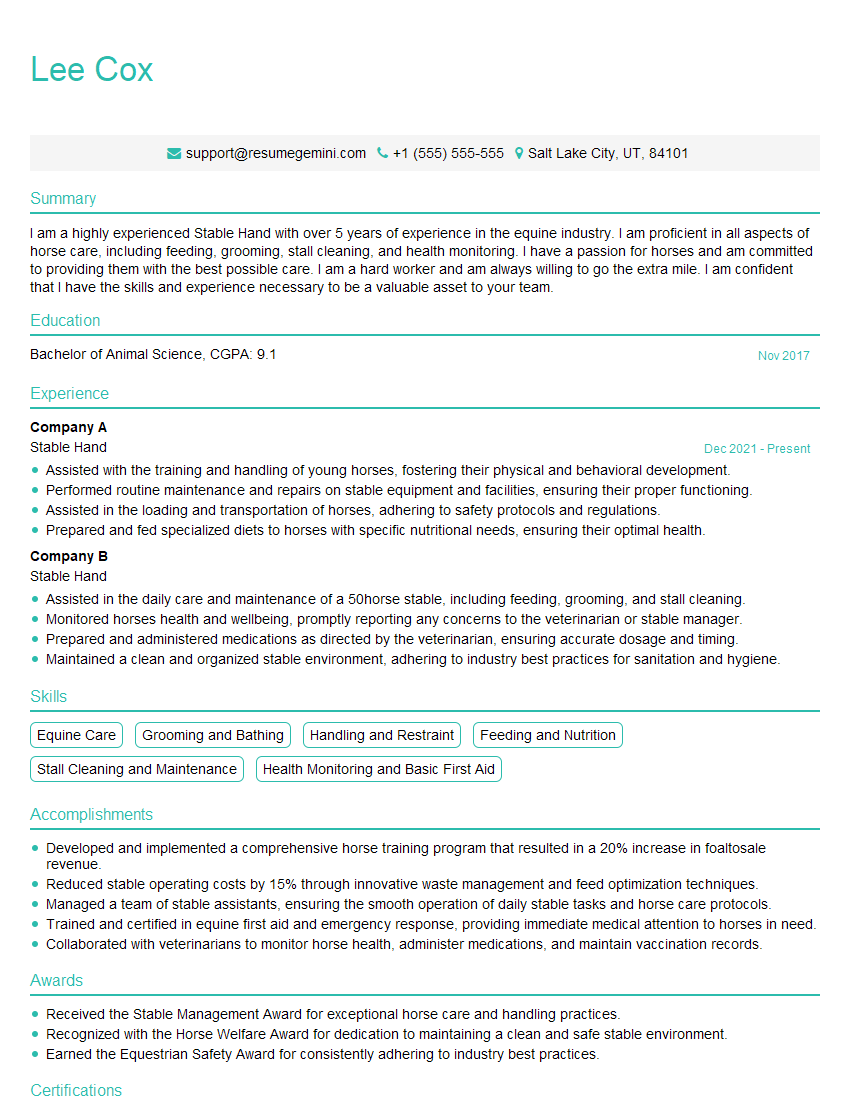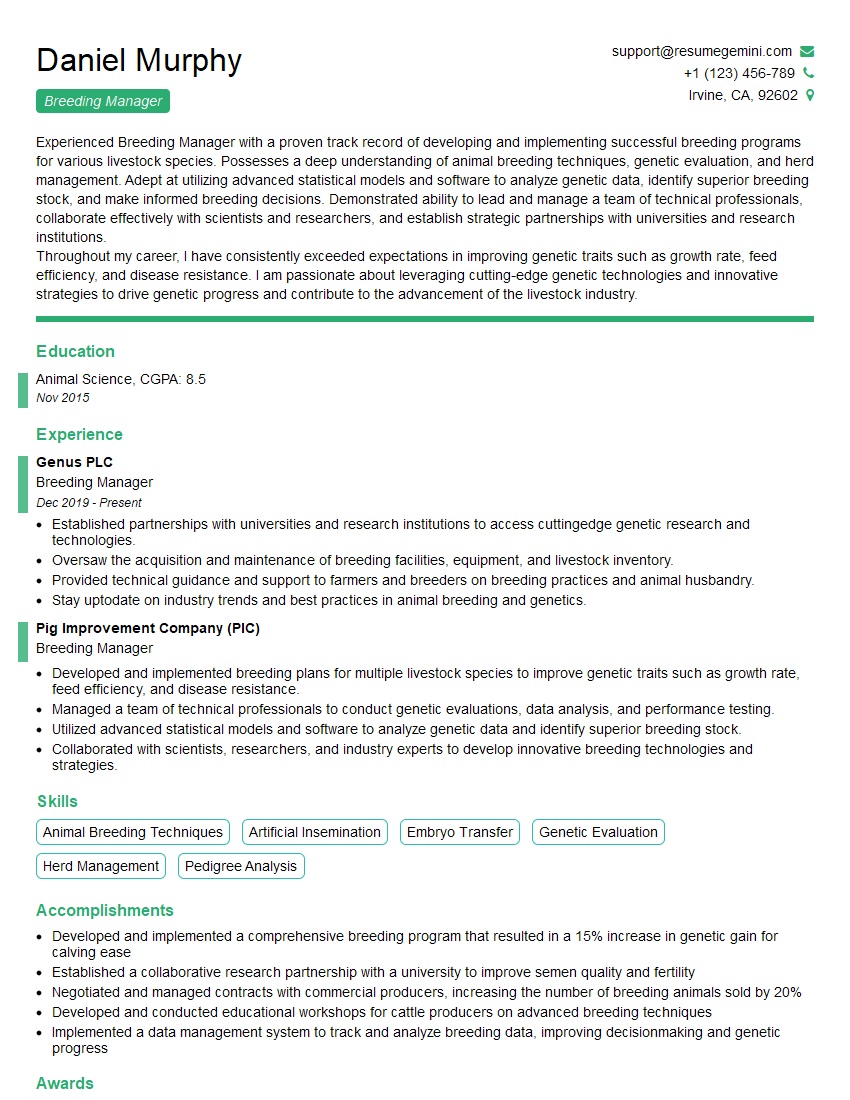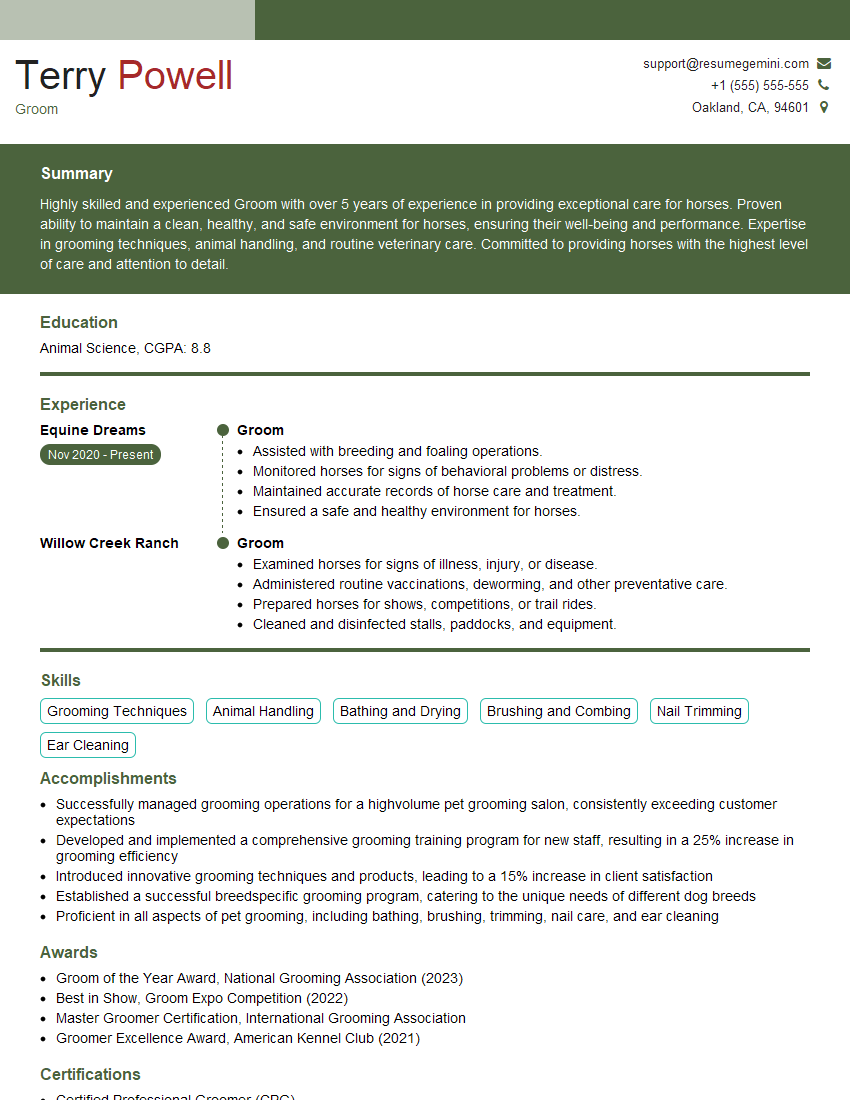Cracking a skill-specific interview, like one for Horseback Riding Skills, requires understanding the nuances of the role. In this blog, we present the questions you’re most likely to encounter, along with insights into how to answer them effectively. Let’s ensure you’re ready to make a strong impression.
Questions Asked in Horseback Riding Skills Interview
Q 1. Describe your experience with different riding disciplines.
My experience spans a wide range of equestrian disciplines. I’ve competed in and instructed English riding styles, including Hunter/Jumper, Dressage, and Eventing. Hunter/Jumper focuses on jumping courses with style and precision, Dressage emphasizes refined movements and obedience, and Eventing combines Dressage, Cross-country, and Show Jumping. I also have significant experience in Western riding, particularly trail riding and working with cow horses. This diverse background allows me to understand the nuances of each discipline and adapt my teaching to suit various learning styles and goals.
- Hunter/Jumper: I’ve competed up to the 3’3″ level and understand the importance of proper form, course strategy, and horse and rider fitness.
- Dressage: My training includes classical dressage principles, emphasizing the development of a strong, supple horse and a harmonious partnership.
- Eventing: I’ve participated in several lower-level competitions, understanding the demands of each phase and the need for overall fitness and stamina.
- Western Riding: My western experience emphasizes safety and horsemanship in various terrain and scenarios.
Q 2. Explain your approach to teaching beginners.
My approach to teaching beginners centers around building a strong foundation of safety and horsemanship. I begin with groundwork, teaching students how to approach, groom, and handle a horse safely and confidently. Once comfortable with the basics, we progress to mounting and dismounting, followed by simple walk and halt exercises. I emphasize proper posture, balance, and communication with the horse. I use positive reinforcement and clear, concise instructions, tailoring my teaching style to each student’s learning pace and abilities. For instance, a nervous student might benefit from extra time spent on groundwork and building trust with the horse before mounting, while a more confident student may progress more quickly.
I use a variety of teaching methods including demonstrations, hands-on practice, and feedback. I believe in creating a positive and supportive learning environment where students feel comfortable asking questions and making mistakes. Safety is paramount, and I constantly supervise and offer guidance to ensure safe practices are maintained at all times.
Q 3. How do you handle a horse exhibiting signs of anxiety or fear?
Handling an anxious or fearful horse requires patience, understanding, and a calm, confident demeanor. It’s crucial to identify the source of anxiety. Is it a specific situation, object, or sound? Once identified, I approach the situation systematically. I might use desensitization techniques, gradually exposing the horse to the source of fear at a distance and rewarding calm behavior. This could involve approaching the scary object slowly, offering treats, and ensuring the horse remains relaxed. If the anxiety stems from physical discomfort, a vet check is crucial. If the anxiety is severe or persistent, professional veterinary or behavioral consultation is essential.
For example, a horse afraid of plastic bags might initially be introduced to the bag from a distance, with positive reinforcement like pats and treats. The distance would gradually reduce as the horse shows no signs of fear.
Q 4. What safety measures do you prioritize while riding and teaching?
Safety is my top priority in all aspects of riding and teaching. I always insist on proper riding attire, including a helmet, long pants, and boots with a small heel. Before each ride, I thoroughly inspect the horse’s tack and equipment for any damage or defects. I ensure the riding area is clear of obstacles and hazards. I communicate clearly and concisely with riders, providing instructions on safe mounting, dismounting, and riding techniques. During lessons, I closely supervise students to ensure they are following safety procedures and using correct techniques. I teach students about horse behavior and how to identify potential hazards. Emergency protocols, including knowledge of first aid for both horses and humans, are regularly reviewed.
Q 5. Detail your experience with horse health and first aid.
My experience with horse health and first aid is extensive. I have hands-on experience in recognizing and responding to common equine injuries, such as wounds, lameness, and colic. I’m proficient in administering basic first aid, including wound cleaning, applying bandages, and providing supportive care until professional veterinary help arrives. I understand the importance of regular preventative care, including hoof care, vaccinations, and dental checkups. I’m also familiar with common equine illnesses and their symptoms, and I know when to seek professional veterinary attention. I stay updated on the latest equine health guidelines and best practices.
For instance, I can recognize the signs of colic – restlessness, pawing, rolling – and can take immediate steps, like ensuring the horse’s safety and notifying a veterinarian.
Q 6. How would you assess a horse’s suitability for a particular rider?
Assessing a horse’s suitability for a particular rider involves careful consideration of both the horse’s temperament and the rider’s experience and abilities. I consider factors such as the horse’s age, training level, temperament, and physical capabilities. For a beginner, I’d recommend a calm, well-trained horse with a gentle disposition. For a more experienced rider, I might suggest a horse that offers more challenge and opportunities for skill development. I always conduct a thorough assessment of the rider’s riding skills, experience, and physical fitness. I would also consider the rider’s goals and preferences. A rider who enjoys trail riding would require a different type of horse than one interested in jumping.
For example, a nervous beginner shouldn’t be paired with a high-spirited, easily excited horse; a steady, predictable mount is essential.
Q 7. Describe your experience with different types of tack and equipment.
My experience encompasses a wide array of tack and equipment, including English and Western saddles, bridles, bits, reins, and other accessories. I understand the purpose and function of different types of tack and how they affect the horse’s comfort and performance. I’m familiar with different saddle styles, such as dressage saddles, hunter saddles, and western saddles, and how each is suited to different riding disciplines. I understand the importance of proper fit and adjustment of tack to ensure comfort and prevent injury. I can also advise on the selection and maintenance of appropriate equipment for different riding styles and levels of experience. For example, I know the difference in bit types and how a milder bit might be suitable for a young horse or nervous rider.
Q 8. How do you maintain a horse’s fitness and wellbeing?
Maintaining a horse’s fitness and wellbeing is paramount to their performance and longevity. It’s a holistic approach encompassing several key areas.
- Nutrition: A balanced diet tailored to the horse’s age, breed, workload, and individual needs is crucial. This involves high-quality hay or pasture, appropriate grain, and potentially supplements under veterinary guidance. For example, a hard-working competition horse will require a higher calorie and protein intake than a retired pasture horse.
- Exercise: Regular, appropriate exercise is essential. This might range from gentle hacking for leisure horses to intensive training for competition horses. The intensity and type of exercise must be carefully managed to avoid injury. A sudden increase in workload, for instance, can lead to strains and tendon injuries.
- Farrier Care: Regular hoof trimming and shoeing (if necessary) are crucial for maintaining soundness and preventing lameness. Improper hoof care can lead to a range of problems, from abscesses to chronic lameness.
- Dental Care: Regular dental checkups are vital, as dental issues can affect a horse’s ability to eat properly, leading to weight loss and other health problems. Sharp points or hooks on the teeth can cause pain and discomfort.
- Veterinary Care: Routine vaccinations and parasite control are essential for preventing disease. Regular veterinary checkups allow for early detection and treatment of any health issues.
- Mental Wellbeing: Providing opportunities for social interaction with other horses, regular turnout in a safe paddock, and minimizing stressful situations contributes to a horse’s mental health. A lonely or stressed horse is more prone to illness.
In short, it’s about building a customized care plan that adapts to the individual horse’s needs and ensuring a proactive rather than reactive approach to health management.
Q 9. What is your experience with horse training techniques?
My experience encompasses a range of horse training techniques, primarily focusing on positive reinforcement and classical dressage principles. I believe in building trust and clear communication with the horse.
- Positive Reinforcement: This method relies on rewarding desired behaviors with treats, praise, or release of pressure. It builds a strong horse-human bond and encourages voluntary compliance, rather than forcing obedience.
- Classical Dressage: This system emphasizes refinement, balance, and suppleness through precise movements. It requires patience, consistency, and a deep understanding of equine biomechanics. For example, I’ve successfully trained several horses to perform advanced dressage movements, such as piaffe and passage, using this method.
- Natural Horsemanship: I incorporate elements of natural horsemanship, focusing on understanding equine body language and herd dynamics. This approach helps create a calm and respectful partnership.
I adapt my techniques to each horse’s individual personality and learning style, prioritizing their wellbeing and safety throughout the process. For example, a young, sensitive horse will require a gentler approach than a more experienced and confident one.
Q 10. How do you manage challenging horse behaviors?
Managing challenging horse behaviors requires patience, understanding, and a systematic approach. It’s crucial to identify the root cause of the behavior before attempting to correct it.
- Identify the Cause: Is the behavior a learned response (e.g., rearing due to inconsistent riding), a reaction to pain or discomfort (e.g., bucking due to back pain), or a result of fear or anxiety (e.g., shying at objects)?
- Professional Help: In many cases, consulting with a veterinarian or equine behaviorist is necessary, especially when dealing with serious behavioral problems. They can rule out medical causes and provide tailored solutions.
- Consistent Training: Once the underlying cause is identified, consistent, positive reinforcement training can help modify unwanted behaviors. This might involve desensitization exercises for fearful horses or counter-conditioning for horses that exhibit aggressive behaviors.
- Environmental Modifications: Altering the horse’s environment can significantly impact behavior. This could involve adjusting stabling arrangements, providing more turnout time, or modifying the riding environment to reduce anxiety.
For instance, I once worked with a horse that was constantly biting its stablemate. After a veterinary checkup ruled out any medical reasons, we focused on providing more space and enrichment to reduce competition for resources, along with positive reinforcement training to reward calm behavior.
Q 11. Explain your understanding of horse anatomy and physiology.
A thorough understanding of horse anatomy and physiology is fundamental for effective riding and training. It informs decisions about exercise, nutrition, and problem-solving.
- Skeletal System: Knowing the structure of the horse’s skeleton is crucial for understanding movement and potential areas of injury. For example, knowing the location and function of the fetlock joint helps in assessing lameness.
- Muscular System: Understanding how muscles work together allows for more effective training techniques. For example, understanding the roles of the gluteal and abdominal muscles is important for correct collection in dressage.
- Digestive System: Awareness of the horse’s digestive system is important for tailoring a suitable diet. Knowing that they are hindgut fermenters helps understand their nutritional needs.
- Respiratory System: Understanding the respiratory system is critical for managing exercise intensity and recognizing signs of respiratory problems, such as heaves (COPD).
- Nervous System: Understanding the horse’s nervous system is vital for interpreting their behavior and applying effective training techniques.
This knowledge allows for proactive management of health, injury prevention, and ultimately, a stronger partnership with the horse. For example, understanding the intricate muscle structure of the back helps in developing training regimens that strengthen and support the horse’s back, reducing the risk of soreness and injuries.
Q 12. How do you identify and address common riding errors?
Identifying and addressing common riding errors requires a keen eye and understanding of the principles of correct riding. Many errors stem from imbalances in the rider’s position or ineffective communication with the horse.
- Posture: Common errors include poor posture, leading to imbalances that affect the horse’s movement and can cause discomfort or injury. I often observe riders leaning too far forward or backward.
- Hand and Seat: Incorrect use of the hands and seat can cause discomfort to the horse’s mouth or back. For example, a harsh or inconsistent hand can create resistance and tension.
- Leg Aids: Ineffective use of the legs leads to confusion for the horse and can result in disobedience or poor performance. I’ve seen riders use their legs too aggressively or not engage them sufficiently.
- Balance: A rider’s lack of balance negatively impacts the horse’s ability to move freely and efficiently. It often manifests as the horse moving unevenly or becoming crooked.
Addressing these errors involves careful observation, clear instruction, and a tailored approach. I often use video analysis and mirrors to help riders identify their own posture and actions, then provide customized exercises to correct the imbalances.
Q 13. What is your approach to risk management in equestrian activities?
Risk management in equestrian activities is critical for the safety of both horse and rider. It’s a multi-faceted approach:
- Rider Safety: This includes wearing appropriate safety equipment such as helmets, body protectors, and boots. Regular riding assessments are essential to ensure the rider is at the appropriate level for the horse and activity.
- Horse Safety: Careful handling procedures are crucial. Knowing how to handle a horse safely, including leading, mounting, and dismounting, is fundamental. Regular hoof and dental care play a significant role here.
- Environmental Safety: Regularly assessing the riding environment, checking fencing, and removing hazards (like loose objects in the arena) are essential.
- Horse Health: Regular veterinary checkups and appropriate management of parasite control play a crucial role in minimizing the risk of illnesses that could lead to accidents.
- Emergency Preparedness: Knowing how to handle emergencies is crucial. Having access to a first aid kit and knowing what to do in case of injury is essential.
Risk management is an ongoing process, not a one-time event. By constantly evaluating and mitigating potential hazards, we significantly enhance the safety and wellbeing of everyone involved in the equestrian activities.
Q 14. How would you handle a horse refusing a jump?
A horse refusing a jump can be due to various reasons – fear, pain, poor technique, or lack of confidence. The approach involves careful diagnosis and systematic desensitization.
- Identify the Cause: Is the horse physically sound? Does the jump present a physical or psychological challenge? Is the approach to the jump correct?
- Veterinary Check-up: Rule out any physical problems that may be causing pain or discomfort, like lameness or soreness.
- Gradual Desensitization: If fear or lack of confidence is the issue, start with small, easily manageable jumps and gradually increase the height and complexity.
- Positive Reinforcement: Reward every attempt, even if the horse doesn’t clear the jump. The focus is on building confidence and rewarding effort.
- Technique Check: Ensure the rider’s approach is correct and that their position doesn’t hinder the horse’s performance.
- Professional Help: If the problem persists, seek guidance from an experienced trainer or instructor. They can help pinpoint the underlying issues and develop a tailored training plan.
Often, it’s a combination of factors. I’ve encountered horses refusing jumps because of poor technique on the rider’s part, for example, inconsistent aids or a poor approach. By working through the causes systematically and providing positive reinforcement, we can help the horse overcome their reluctance and regain confidence.
Q 15. Describe your experience with horse transportation and handling.
My experience with horse transportation and handling encompasses years of practical experience, from loading and unloading horses in various trailers to ensuring their safe and comfortable transport. I’m proficient in different loading techniques, adjusting to the temperament and size of individual horses. I understand the importance of proper trailer ventilation, secure tie-down methods, and regular checks during transit to prevent injury or stress. For example, I’ve successfully transported a particularly nervous mare by utilizing a calm approach, slow loading, and a familiar blanket to provide comfort. In addition to transport, I am experienced in safe handling procedures, including leading, grooming, and stable management, always prioritizing the horse’s well-being and safety.
This involves understanding their body language and reacting appropriately to potential anxieties. For example, I’ve used desensitization techniques to help a stallion comfortable with trailer loading and even the sounds of traffic.
Career Expert Tips:
- Ace those interviews! Prepare effectively by reviewing the Top 50 Most Common Interview Questions on ResumeGemini.
- Navigate your job search with confidence! Explore a wide range of Career Tips on ResumeGemini. Learn about common challenges and recommendations to overcome them.
- Craft the perfect resume! Master the Art of Resume Writing with ResumeGemini’s guide. Showcase your unique qualifications and achievements effectively.
- Don’t miss out on holiday savings! Build your dream resume with ResumeGemini’s ATS optimized templates.
Q 16. How do you build rapport and trust with horses?
Building rapport and trust with horses is a cornerstone of horsemanship. It’s built on respect, patience, and consistent positive reinforcement. It starts with observation – understanding their body language to anticipate their reactions and adjust my approach accordingly. I use gentle, calm interactions. This includes soft touch, quiet voice, and avoiding sudden movements. I focus on rewarding desired behaviors with praise and treats, building a positive association. For example, if a horse approaches willingly when I offer a hand, I immediately praise and reward them. Consistency is key; maintaining a predictable routine helps build confidence and trust.
I also find that spending time simply being present with a horse, grooming and observing, strengthens the bond. It allows them to become accustomed to my presence, creating a safe and comfortable environment. This helps them relax and readily accept my guidance.
Q 17. What are the signs of a lame horse?
Recognizing lameness in a horse requires keen observation. Several signs indicate a problem, and it’s crucial to distinguish between temporary discomfort and a more serious condition. Obvious signs include limping or shortening of a stride, head bobbing (to compensate for leg pain), reluctance to move, or signs of pain when the leg is touched. Subtle indicators are often missed by the untrained eye, such as favoring one leg, altered gait, heat or swelling in a joint, or muscle atrophy in the affected limb. It is important to note, a subtle change in gait, such as one slightly shorter stride, is a valid indicator of lameness. Even a subtle deviation from normal movement can be significant.
If any of these signs are present, it’s crucial to consult a veterinarian immediately to determine the cause and implement appropriate treatment. Early diagnosis is key to preventing long-term damage.
Q 18. How do you conduct a pre-ride inspection of a horse?
A thorough pre-ride inspection is vital for the safety of both horse and rider. I begin by visually inspecting the horse’s overall condition, checking for any cuts, bruises, or swelling. Then, I examine their hooves, ensuring they are clean, properly trimmed and shod, and there are no signs of injury. I carefully check the girth and other tack to ensure proper fit, adjusting straps for comfort and ensuring no buckles or straps are broken or damaged. I palpate their legs and joints, checking for heat, swelling, or pain, any abnormal sounds or movement. I then assess the saddle, checking that it fits properly and is securely fastened. I make sure there is no debris or anything that could cause irritation. Finally, I check that any bridle equipment is intact and well-fitted. This rigorous examination is essential for preventing accidents and ensuring both the horse and rider are ready for a safe and productive ride.
Q 19. How would you manage a situation with a difficult or aggressive horse?
Handling a difficult or aggressive horse requires patience, experience, and a calm demeanor. It’s crucial to understand the underlying cause of the aggression – it may stem from pain, fear, or poor training. I never approach aggressively, instead maintaining a calm, respectful distance. I assess the situation, observing the horse’s body language. I try to identify any triggers and avoid them, using slow movements and a quiet voice to minimize the possibility of inciting a reaction. I would use positive reinforcement methods, such as rewarding calm behavior with treats or praise. In some cases, professional help, from a veterinarian or experienced equine behaviorist, may be necessary.
For example, if a horse is exhibiting signs of fear or anxiety I would use desensitization techniques to slowly introduce them to the scary element. Safety is paramount. If the situation escalates beyond my ability to manage it safely, I would seek assistance from experienced handlers or professionals immediately.
Q 20. Describe your experience with different types of riding surfaces.
My experience with various riding surfaces is extensive. Each presents unique challenges and requires adjustments in riding style and technique. Riding on soft surfaces like sand or grass requires a different approach than riding on hard surfaces like pavement or hard-packed dirt. Sand, for example, can be tiring for both the horse and rider and can cause fatigue and even injury. Hard surfaces can cause more stress on the horse’s joints. I adjust my riding accordingly; for example, I’ll maintain a more collected gait and have a gentler seat to absorb the shock of the hard surface. On softer surfaces, I will use a longer, more expansive stride but still maintaining control. On uneven ground, I adjust my posture and position to ensure both the horse’s and my balance. Adaptability to different terrains is essential for rider safety and the horse’s well-being.
Q 21. How do you adapt your teaching style to different learning abilities?
Adapting my teaching style to different learning abilities is paramount. I employ a multifaceted approach that caters to diverse learning preferences. Visual learners benefit from demonstrations and visual aids, such as diagrams or videos. Auditory learners respond well to clear verbal explanations and feedback. Kinesthetic learners, those who learn best through hands-on experience, require more practical exercises and personalized guidance. I assess each student’s strengths and weaknesses during the initial session, tailoring instruction to their unique learning style. For example, if a student struggles with balance, I’ll dedicate extra time to exercises focused on improving core strength and postural awareness. I provide constructive feedback and adjust my approach as needed, ensuring that each student understands the concepts and is able to implement them effectively. Patience, positive reinforcement and clear communication remain key elements of my methodology.
Q 22. What are some common riding injuries and how can they be prevented?
Common riding injuries often stem from falls, being struck by the horse, or repetitive strain. Preventing these requires a multi-faceted approach focusing on rider skill, horse management, and equipment.
Falls: Proper riding posture, balanced seat, and effective communication with the horse minimize the risk. Regular lessons with a qualified instructor build essential skills. Always ride a horse suitable for your skill level. For example, a beginner shouldn’t ride a highly spirited horse.
Being struck: Understanding equine behavior is crucial. Horses can react unpredictably to sudden movements or noises. Maintaining a safe distance from the horse’s feet and head is paramount. Using appropriate riding attire, such as a helmet, protects against impact.
Repetitive strain injuries: These affect muscles and joints from prolonged riding or incorrect posture. Regular stretching before and after riding, maintaining correct posture, and taking breaks prevent these. Using proper stirrup length and saddle fit also minimizes strain.
Ultimately, rider education and consistent safe practices are the best preventative measures. Regular veterinary checkups for the horse are also critical to ensuring soundness and reducing risk.
Q 23. Describe your experience with horse nutrition and feeding.
Horse nutrition is fundamental to their health, performance, and well-being. My experience encompasses formulating balanced diets based on the horse’s age, breed, work level, and individual needs. I consider factors like hay quality, supplements, and the appropriate amount of grain or concentrates.
For example, a young, growing horse requires a higher-calorie diet than an older, less active horse. A competition horse needs more calories and specific nutrients to support its training workload. I’ve worked with various feed brands and tailored rations based on nutritional analysis, considering both the macronutrients (carbohydrates, protein, fats) and micronutrients (vitamins, minerals).
I’ve also addressed nutritional deficiencies in horses through diet adjustments and supplementation, working closely with veterinarians where necessary. Regular monitoring of weight, body condition score, and manure consistency allows for timely adjustments to ensure the horse is thriving.
Q 24. How do you maintain the cleanliness and organization of a stable?
Maintaining a clean and organized stable is crucial for both horse and human well-being. It prevents the spread of disease and ensures a safe working environment.
Daily Cleaning: This includes mucking out stalls (removing manure and soiled bedding), sweeping aisles, and cleaning water troughs. Regular grooming of the horses also contributes to a clean stable environment.
Disinfection: Periodic disinfection of stalls and equipment using approved veterinary disinfectants prevents disease outbreaks.
Storage: Hay, feed, and equipment should be stored neatly and in a way that prevents spoilage and accidents. This includes proper labeling of feed to track usage and expiration dates.
Pest control: Regular pest control measures, such as fly control and rodent prevention, are necessary for maintaining a hygienic environment.
A well-organized stable reflects efficient management and contributes significantly to the health and happiness of the horses.
Q 25. What is your experience with horse breeding and reproduction?
My experience with horse breeding and reproduction is extensive, encompassing aspects from mare management during pregnancy to foal care. I understand the importance of accurate record-keeping, including pedigrees, breeding soundness evaluations, and reproductive cycles.
I’ve assisted with various breeding techniques, including natural mating and artificial insemination, and have monitored pregnancies using ultrasound. Post-foaling care, including monitoring the foal’s health and ensuring adequate colostrum intake, is critical and forms a significant part of my expertise. I’m familiar with common reproductive issues in mares and stallions and their management. For example, I’ve dealt with instances of dystocia (difficult birth) and assisted veterinarians with successful foal delivery.
Q 26. How do you manage conflict between riders or staff?
Conflict resolution requires a calm and professional approach. My strategy emphasizes open communication and active listening. I facilitate discussions between conflicting parties, aiming to understand each person’s perspective before suggesting solutions.
For example, if two riders disagree about stable chores, I would bring them together, listen to their concerns, and then collaboratively devise a fair and equitable schedule. If a staff member has a complaint, I encourage them to express it openly, and I work to address the issue fairly and constructively. Sometimes, simply improving communication channels and defining roles and responsibilities prevent future conflict.
Q 27. How do you prioritize rider safety in group riding lessons?
Rider safety is my top priority in group lessons. I structure lessons to ensure appropriate spacing between riders and implement clear instructions and rules. I ensure that all riders are equipped with appropriate safety gear, including helmets and properly fitted riding attire.
I match riders with horses suitable for their skill level. I continuously supervise the group, providing individual guidance and addressing any safety concerns promptly. For instance, I might separate less experienced riders from more advanced ones to prevent accidents. A structured warm-up and cool-down session are also incorporated to prevent injuries. Regular safety briefings before lessons reinforce safety protocols.
Q 28. Describe your experience with different types of saddles and their uses.
Different saddles are designed for various riding disciplines and horse types. My experience covers a wide range of saddles, each with its own unique features and applications.
English Saddles: These are used in disciplines like dressage, jumping, and hunting. Examples include the dressage saddle, emphasizing a deep seat for balance, and the jumping saddle, featuring a flatter seat and knee rolls for stability.
Western Saddles: These are characterized by their large, deep seat, high pommel, and cantle. They are designed for comfort during long rides and are used in disciplines like trail riding, reining, and roping.
Endurance Saddles: These saddles prioritize rider comfort and the horse’s well-being during long-distance rides. They often feature lightweight designs and features to minimize pressure points.
Choosing the correct saddle involves considering the rider’s skill level, the horse’s conformation, and the riding discipline. Proper saddle fitting is crucial for both rider comfort and the horse’s back health. I regularly assess saddle fit to prevent sores or discomfort.
Key Topics to Learn for Horseback Riding Skills Interview
- Horse Handling & Safety: Understanding horse behavior, safe mounting and dismounting procedures, and emergency response protocols. Practical application: Demonstrate knowledge of recognizing signs of stress or illness in a horse and explaining appropriate responses.
- Riding Techniques & Disciplines: Proficiency in various riding styles (e.g., English, Western, dressage) including posture, balance, and aids. Practical application: Explain the differences between various riding disciplines and demonstrate understanding of the specific skills required for each.
- Equine Health & Care: Knowledge of horse anatomy, common health issues, grooming, and stable management. Practical application: Discuss preventative health measures and describe routine care procedures.
- Tack & Equipment: Understanding different types of saddles, bridles, and other equipment, and their proper use and maintenance. Practical application: Explain the function of various pieces of tack and how they affect the horse’s performance and comfort.
- Training & Communication: Effective communication with horses using body language and aids. Practical application: Describe different training methods and their effectiveness, considering the horse’s individual needs and temperament.
- Problem-Solving & Decision-Making: Responding to unexpected situations, such as a spooked horse or equipment malfunction. Practical application: Describe how you would address a specific challenging scenario during a ride.
Next Steps
Mastering horseback riding skills opens doors to exciting career opportunities in various equestrian fields. To significantly boost your job prospects, crafting an ATS-friendly resume is crucial. ResumeGemini is a trusted resource that can help you build a professional and impactful resume, maximizing your chances of landing your dream job. We provide examples of resumes tailored to showcase Horseback Riding Skills, helping you present your qualifications effectively.
Explore more articles
Users Rating of Our Blogs
Share Your Experience
We value your feedback! Please rate our content and share your thoughts (optional).
What Readers Say About Our Blog
Hi, I’m Jay, we have a few potential clients that are interested in your services, thought you might be a good fit. I’d love to talk about the details, when do you have time to talk?
Best,
Jay
Founder | CEO
